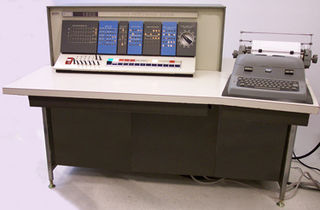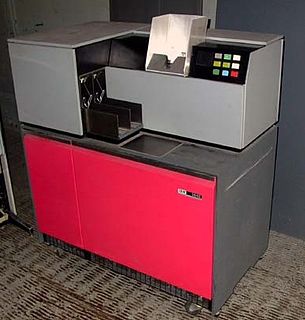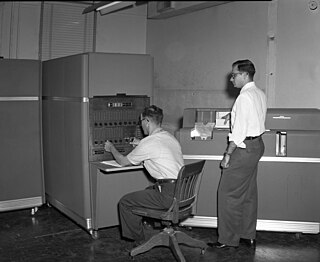
IBM 357 Data Collection System is a now obsolete punched card-based terminal system for sending and receiving remote data.
It consisted of: [1]

IBM 357 Data Collection System is a now obsolete punched card-based terminal system for sending and receiving remote data.
It consisted of: [1]
The IBM 357 system was announced worldwide in 1959. [2] It began to be installed the following year, at libraries, manufacturing plants, etc.
The IBM 1030 Data Collection System and IBM 1050 Data Communications System were typically used in an office environment; the IBM 357 system carried out similar functions in manufacturing plants, for example steel mills.
Many of the devices are described and pictured in 1961 IBM Data Collection in the Factory manual.

A punched card is a piece of stiff paper that holds digital data represented by the presence or absence of holes in predefined positions. Punched cards were once common in data processing applications or to directly control automated machinery.

Punched tape or perforated paper tape is a form of data storage that consists of a long strip of paper in which holes are punched. It developed from and was subsequently used alongside punched cards, differing in that the tape is continuous.

The IBM 1620 was announced by IBM on October 21, 1959, and marketed as an inexpensive scientific computer. After a total production of about two thousand machines, it was withdrawn on November 19, 1970. Modified versions of the 1620 were used as the CPU of the IBM 1710 and IBM 1720 Industrial Process Control Systems.

The IBM 650 Magnetic Drum Data-Processing Machine is an early digital computer produced by IBM in the mid-1950s. It was the first mass produced computer in the world. Almost 2,000 systems were produced, the last in 1962, and it was the first computer to make a meaningful profit. The first one was installed in late 1954 and it was the most-popular computer of the 1950s.

The IBM Series/1 is a 16-bit minicomputer, introduced in 1976, that in many respects competed with other minicomputers of the time, such as the PDP-11 from Digital Equipment Corporation and similar offerings from Data General and HP. The Series/1 was typically used to control and operate external electro-mechanical components while also allowing for primitive data storage and handling.

IBM 1442 is a combination IBM card reader and card punch. It reads and punches 80-column IBM-format punched cards and is used on the IBM 1440, the IBM 1130, the IBM 1800 and System/360 and is an option on the IBM System/3.

Starting at the end of the nineteenth century, well before the advent of electronic computers, data processing was performed using electromechanical machines collectively referred to as unit record equipment, electric accounting machines (EAM) or tabulating machines. Unit record machines came to be as ubiquitous in industry and government in the first two-thirds of the twentieth century as computers became in the last third. They allowed large volume, sophisticated data-processing tasks to be accomplished before electronic computers were invented and while they were still in their infancy. This data processing was accomplished by processing punched cards through various unit record machines in a carefully choreographed progression. This progression, or flow, from machine to machine was often planned and documented with detailed flowcharts that used standardized symbols for documents and the various machine functions. All but the earliest machines had high-speed mechanical feeders to process cards at rates from around 100 to 2,000 per minute, sensing punched holes with mechanical, electrical, or, later, optical sensors. The operation of many machines was directed by the use of a removable plugboard, control panel, or connection box. Initially all machines were manual or electromechanical. The first use of an electronic component was in 1937 when a photocell was used in a Social Security bill-feed machine. Electronic components were used on other machines beginning in the late 1940s.

A keypunch is a device for precisely punching holes into stiff paper cards at specific locations as determined by keys struck by a human operator. Other devices included here for that same function include the gang punch, the pantograph punch, and the stamp. The term was also used for similar machines used by humans to transcribe data onto punched tape media.

The IBM 407 Accounting Machine, introduced in 1949, was one of a long line of IBM tabulating machines dating back to the days of Herman Hollerith. It had a card reader and printer; a summary punch could be attached. Processing was directed by a control panel.

The IBM 305 RAMAC was the first commercial computer that used a moving-head hard disk drive for secondary storage. The system was publicly announced on September 14, 1956, with test units already installed at the U.S. Navy and at private corporations. RAMAC stood for "Random Access Method of Accounting and Control", as its design was motivated by the need for real-time accounting in business.

From the invention of computer programming languages up to the mid-1970s, most computer programmers created, edited and stored their programs line by line on punch cards.

The IBM 2540 is a punched-card computer peripheral manufactured by IBM Corporation for use of System/360 and later computer systems. The 2540 was designed by IBM's Data Processing Division in Rochester, Minnesota, and was introduced in 1965. The 2540 can read punched-cards at 1000 cards per minute (CPM) and punch at 300 CPM. The 2540 is based on the design of the older, slightly slower, 1402.
The IBM 2780 and the IBM 3780 are devices developed by IBM to perform remote job entry (RJE) and other batch functions over telephone lines; they communicate with the mainframe via Binary Synchronous Communications and replaced older terminals using synchronous transmit-receive (STR). In addition, IBM has developed workstation programs for the 1130, 360/20, 2922, System/360 other than 360/20, System/370 and System/3.

A computer punched card reader or just computer card reader is a computer input device used to read computer programs in either source or executable form and data from punched cards. A computer card punch is a computer output device that punches holes in cards. Sometimes computer punch card readers were combined with computer card punches and, later, other devices to form multifunction machines. It is a input device and also an output device. Most early computers, such as the ENIAC, and the IBM NORC, provided for punched card input/output. Card readers and punches, either connected to computers or in off-line card to/from magnetic tape configurations, were ubiquitous through the mid-1970s.

The IBM 533 Input-Output Unit, announced on July 2, 1953, was a punched card reader and punch that served as the primary input-output unit for the IBM 650 computer. It had two independent card paths, one for reading and one for punching. IBM cards were fed face down, 12-edge first. All 80 columns could be read and punched by the computer as numeric data, but alphanumeric reading was severely limited on the basic 650 and require special control panel wiring.
The IBM 2790 Data Communications System is a family of devices intended for "in-plant data communications and production monitoring." It is described as a two-way data communications system designed to accommodate large volumes of short messages from many in-plant locations or from smaller groups of terminals at remote locations.
The IBM 1030 Data Collection System was a remote terminal system created by IBM in Endicott, New York in 1963, intended to transmit data from remote locations to a central computer system.

The IBM System/360 Model 20 is the smallest member of the IBM System/360 family announced in November 1964. The Model 20 supports only a subset of the System/360 instruction set, with binary numbers limited to 16 bits and no floating point. In later years it would have been classified as a 16-bit minicomputer rather than a mainframe, but the term "minicomputer" was not current, and in any case IBM wanted to emphasize the compatibility of the Model 20 rather than its differences from the rest of the System/360 line. It does, however, have the full System/360 decimal instruction set, that allows for addition, subtraction, product, and dividend of up to 31 decimal digits.

IBM designed, manufactured and sold optical mark and character readers from 1960 until 1984. The IBM 1287 is notable as being the first commercially sold scanner capable of reading handwritten numbers.